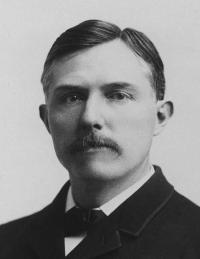1917
As a poverty-stricken photographer’s assistant in Tennessee, young Edward Barnard made his own telescope and discovered several comets. These discoveries led to his gaining an education at Vanderbilt University and joining the initial staff of the Lick Observatory, where, with his exceptionally keen vision and the new 36-inch Lick refractor, he discovered Amalthea, the fifth known moon of Jupiter. In 1895 he moved to the not-yet-completed Yerkes Observatory. He made many studies, both visual and photographic, of the physical features of planets, comets, nebulae, and novae. Barnard’s careful drawings of Mars were used by the astronomical community as evidence for the nonexistence of canals on Mars. His greatest achievement was the introduction of wide-field photographic methods to study the structure of the Milky Way. This was done concurrently by Max Wolf in Germany, and the two praised each other's work. He discovered dark clouds and globules and the star with the largest known proper motion.
Presentation of Bruce medal
Townley, Sidney D., PASP 29, 77-87 (1917)
Other awards
French Academy of Sciences, Lalande (1892), Arago (1893), and Janssen (1900) Gold Medals.
Royal Astronomical Society, Gold medal, 1897, presented by A.A. Common, MNRAS 57, 321-28 (1897).
Biographical materials
Burnham, S.W., [3 articles on Barnard's life and work]; Popular Astronomy 1, 193-95; 341-45; 441-47 (1893).
Chandler, Walter, The Challenge of Handicap; How Four Tennesseans Met the Dare and Won, (Walter Chandler, Nashville, TN, 1964).
Frost, Edwin B., Scientific Memoirs of the National Academy of Science 21 (14) 1-23.
Hardie, Robert H., “The Early Life of E.E. Barnard,” Leaflets of the Astronomical Society of the Pacific 9, 113-20 (1964) [Leaflet #415] and 121-28 (1964) [Leaflet #416].
Paterson, John A., “Edward Emerson Barnard, his Life and Work,” JRASC 18, 309-18 (1924).
Sheehan, William,The Immortal Fire within: the Life and Work of Edward Emerson Barnard (Cambridge Univ. Press, Cambridge, UK, 1995).
Tenn, Joseph S., “Edward E. Barnard: The Fourteenth Bruce Medalist,” Mercury 21, 5, 164 (1992).
Obituaries
Aitken, R.G., PASP 35, 87-94 (1923).
D[enning], W.F.., MNRAS 84, 221-225 (1924).
Fox, Philip, Popular Astronomy 31, 195-200 (1923).
Frost, Edwin B., Ap. J. 58, 1-35 (1923).
Mitchell, S.A., Observatory 46, 158-64 (1923).
Parkhurst, J.A., JRASC 17, 97-103 (1923).
Portraits
AIP Center for History of Physics
Georgia Tech, “A Photographic Atlas of Selected Regions of the Milky Way”
Steinicke, Wolfgang, “Edward Emerson Barnard”
Named after him
Lunar crater Barnard
Martian crater Barnard
Barnard Regio, a region on Ganymede
Minor Planet #819 Barnardiana
Barnard’s Star
Barnard Hall at Vanderbilt University
